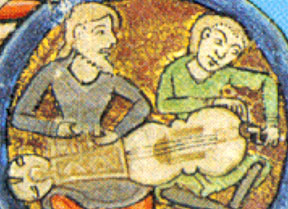A string instrument that was set up primarily for the purpose of making drones was the hurdy-gurdy; at least, that is the modern name for it. In the Middle Ages, it was known in Latin as the organistrum and the symphonia, and in French as the vielle à roue (the vielle with the wheel).
Hurdy-gurdy. Trouvères: Courtly Love Songs from Northern France. Ensemble Sequentia. Benjamin Bagby, symphonia. Deutsche Harmonia Mundi RD77155-2-RC (1984). Trk 14c Gracieusette (excerpt).
The hurdy-gurdy’s sound was produced when a rosined wooden wheel, turned by a crank, set a number of strings in continuous droning vibration; one of these was also a melody string which could play tunes by being stopped by keys along its length.
The hurdy-gurdy made its first appearance in the 10th century, at the same time as the regular vielle, but as a large and unwieldy, two-person instrument. In the 13th century, it was reduced in size and seems thereafter to have become increasingly popular.
![]()




